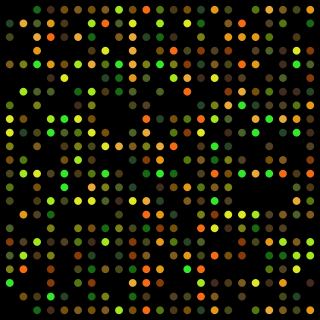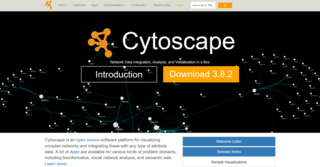
Functional genomics is a field of molecular biology that attempts to make use of the vast wealth of data given by genomic and transcriptomic projects to describe gene functions and interactions. Unlike structural genomics, functional genomics focuses on the dynamic aspects such as gene transcription, translation, regulation of gene expression and protein–protein interactions, as opposed to the static aspects of the genomic information such as DNA sequence or structures. Functional genomics attempts to answer questions about the function of DNA at the levels of genes, RNA transcripts, and protein products. A key characteristic of functional genomics studies is their genome-wide approach to these questions, generally involving high-throughput methods rather than a more traditional “gene-by-gene” approach.
A sequence profiling tool in bioinformatics is a type of software that presents information related to a genetic sequence, gene name, or keyword input. Such tools generally take a query such as a DNA, RNA, or protein sequence or ‘keyword’ and search one or more databases for information related to that sequence. Summaries and aggregate results are provided in standardized format describing the information that would otherwise have required visits to many smaller sites or direct literature searches to compile. Many sequence profiling tools are software portals or gateways that simplify the process of finding information about a query in the large and growing number of bioinformatics databases. The access to these kinds of tools is either web based or locally downloadable executables.
The Bioinformatic Harvester was a bioinformatic meta search engine created by the European Molecular Biology Laboratory and subsequently hosted and further developed by KIT Karlsruhe Institute of Technology for genes and protein-associated information. Harvester currently works for human, mouse, rat, zebrafish, drosophila and arabidopsis thaliana based information. Harvester cross-links >50 popular bioinformatic resources and allows cross searches. Harvester serves tens of thousands of pages every day to scientists and physicians. Since 2014 the service is down.
The Biomolecular Object Network Databank is a bioinformatics databank containing information on small molecule and, structures and interactions. The databank integrates a number of existing databases to provide a comprehensive overview of the information currently available for a given molecule.
BLAT is a pairwise sequence alignment algorithm that was developed by Jim Kent at the University of California Santa Cruz (UCSC) in the early 2000s to assist in the assembly and annotation of the human genome. It was designed primarily to decrease the time needed to align millions of mouse genomic reads and expressed sequence tags against the human genome sequence. The alignment tools of the time were not capable of performing these operations in a manner that would allow a regular update of the human genome assembly. Compared to pre-existing tools, BLAT was ~500 times faster with performing mRNA/DNA alignments and ~50 times faster with protein/protein alignments.

Cytoscape is an open source bioinformatics software platform for visualizing molecular interaction networks and integrating with gene expression profiles and other state data. Additional features are available as plugins. Plugins are available for network and molecular profiling analyses, new layouts, additional file format support and connection with databases and searching in large networks. Plugins may be developed using the Cytoscape open Java software architecture by anyone and plugin community development is encouraged. Cytoscape also has a JavaScript-centric sister project named Cytoscape.js that can be used to analyse and visualise graphs in JavaScript environments, like a browser.

MicrobesOnline is a publicly and freely accessible website that hosts multiple comparative genomic tools for comparing microbial species at the genomic, transcriptomic and functional levels. MicrobesOnline was developed by the Virtual Institute for Microbial Stress and Survival, which is based at the Lawrence Berkeley National Laboratory in Berkeley, California. The site was launched in 2005, with regular updates until 2011.
DAVID is a free online bioinformatics resource developed by the Laboratory of Immunopathogenesis and Bioinformatics. All tools in the DAVID Bioinformatics Resources aim to provide functional interpretation of large lists of genes derived from genomic studies, e.g. microarray and proteomics studies. DAVID can be found at http://david.niaid.nih.gov or http://david.abcc.ncifcrf.gov

Strand Life Sciences, formerly Strand Genomics, is a Bengaluru, India-based in silico technology company. Strand focuses in data mining, predictive modeling, computational chemistry, software engineering, bioinformatics, and research biology to develop software and services for life sciences research. Strand also offers custom solutions based on its intellectual property. In August 2007, Strand and Agilent Technologies, Inc. entered an agreement in which Strand develops and supports Agilent's GeneSpring software which Agilent obtained through Silicon Genetics acquisition in August 2004. In October 2010, Strand and Agilent renewed the agreement for Strand to expand the scope of Agilent's GeneSpring across multiple life sciences disciplines.
GeneCards is a database of human genes that provides genomic, proteomic, transcriptomic, genetic and functional information on all known and predicted human genes. It is being developed and maintained by the Crown Human Genome Center at the Weizmann Institute of Science. This database aims at providing a quick overview of the current available biomedical information about the searched gene, including the human genes, the encoded proteins, and the relevant diseases. The GeneCards database provides access to free Web resources about more than 7000 all known human genes that integrated from >90 data resources, such as HGNC, Ensembl, and NCBI. The core gene list is based on approved gene symbols published by the HUGO Gene Nomenclature Committee (HGNC). The information are carefully gathered and selected from these databases by the powerful and user-friendly engine. If the search does not return any results, this database will give several suggestions to help users accomplish their searching depended on the type of query, and offer direct links to other databases’ search engine. Over time, the GeneCards database has developed a suite of tools that has more specialised capability. Since 1998, the GeneCards database has been widely used by bioinformatics, genomics and medical communities for more than 15 years.
A biological pathway is a series of interactions among molecules in a cell that leads to a certain product or a change in a cell. Such a pathway can trigger the assembly of new molecules, such as a fat or protein. Pathways can also turn genes on and off, or spur a cell to move. Some of the most common biological pathways are involved in metabolism, the regulation of gene expression and the transmission of signals. Pathways play a key role in advanced studies of genomics.

HIKESHI is a protein important in lung and multicellular organismal development that, in humans, is encoded by the HIKESHI gene. HIKESHI is found on chromosome 11 in humans and chromosome 7 in mice. Similar sequences (orthologs) are found in most animal and fungal species. The mouse homolog, lethal gene on chromosome 7 Rinchik 6 protein is encoded by the l7Rn6 gene. When the l7Rn6 protein is disrupted in mice, the mice display severe emphysema at birth as a result of disorganization of the Golgi apparatus and formation of aberrant vesicular structures within club cells.
QIAGEN Silicon Valley is a company based in Redwood City, California, USA, to analyze complex biological systems. QIAGEN Silicon Valley's first product, IPA, was introduced in 2003, and is used to help researchers analyze omics data and model biological systems. The software has been cited in thousands of scientific molecular biology publications and is one of several tools for systems biology researchers and bioinformaticians in drug discovery and institutional research.
The NAS Award in Molecular Biology is awarded by the U.S. National Academy of Sciences "for recent notable discovery in molecular biology by a young scientist who is a citizen of the United States." It has been awarded annually since its inception in 1962.

ArrayTrack is a multi-purpose bioinformatics tool primarily used for microarray data management, analysis, and interpretation. ArrayTrack was developed to support in-house filter array research for the U.S. Food and Drug Administration in 2001 and was made freely available to the public as an integrated research tool for microarrays in 2003. Since then, ArrayTrack has averaged about 5,000 users per year. It is regularly updated by the National Center for Toxicological Research.
Integromics is a global bioinformatics company headquartered in Granada, Spain, with a second office in Madrid and subsidiaries in the US and UK and distributors in 10 countries. Integromics S.L. provides bioinformatics software for data management and data analysis in genomics and proteomics. The company provides a line of products that serve the gene expression, sequencing and proteomics markets. Customers include genomic research centers, pharmaceutical companies, academic institutions, clinical research organizations and biotechnology companies.
In bioinformatics research, pathway analysis software is used to identify related proteins within a pathway or building pathway de novo from the proteins of interest. This is helpful when studying differential expression of a gene in a disease or analyzing any omics dataset with a large number of proteins. By examining the changes in gene expression in a pathway, its biological causes can be explored. Pathway is the term from molecular biology which depicts an artificial simplified model of a process within a cell or tissue. Typical pathway model starts with extracellular signaling molecule that activates a specific protein. Thus triggers a chain of protein-protein or protein-small molecule interactions. Pathway analysis helps to understand or interpret omics data from the point of view of canonical prior knowledge structured in the form of pathways diagrams. It allows finding distinct cell processes, diseases or signaling pathways that are statistically associated with selection of differentially expressed genes between two samples. Often but erroneously pathway analysis is used as synonym for network analysis.
Metascape is a free gene annotation and analysis resource that helps biologists make sense of one or multiple gene lists. Metascape provides automated meta-analysis tools to understand either common or unique pathways and protein networks within a group of orthogonal target-discovery studies.








